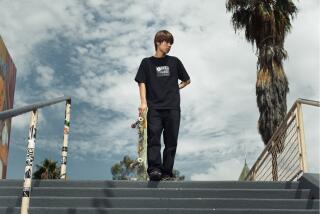Breaching the Steep Facade to His Lot in Life
- Share via
On the road to the Dead Sea via the desolate Jordan Valley, we stopped to visit Masada. It is what we might call a mesa--a massive mountain with a flat top and steep sides. The Jews consider it a shrine and a symbol of their resolution to be free.
It was to Masada that a group of zealous Jews fled to escape the Roman conquerors. In 40 BC, Herod the Great, a Roman tool, had built a sumptuous palace and mighty fortress on the rock to protect himself from the Jews. In AD 70, when the Romans crushed Jerusalem, fewer than 1,000 Jews overcame the Roman garrison and refortified their stronghold.
But the Romans sent their best legion, with thousands of slaves to carry water and provisions, and laid siege. For months the Jews held out. Finally the Romans built a ramp to the top, used a battering ram to breach the wall, then surged in, only to find the beleaguered Jews all dead by their own hands.
According to the historian Josephus, the Jewish leader had made a dramatic speech urging death before slavery and dishonor. Then each man killed his wife and children. Lots were cast for 10 men who would kill the others. Lots were drawn again for the one man who would kill the other nine. Then he fell on his own sword.
I don’t know how Josephus knew all this--especially the text of the Jewish leader’s heroic speech. But in the Holy Land the facts are so entwined with mythology and “tradition” that it is pointless to question them.
We took an aerial car up the mountain’s steep facade and then walked 97 steps to the top. Many ruins of the old fortress remain; also many ruins of Herod’s palace. Herod was a great builder. He left his mark all over the land. But like many other men history calls great, he was a megalomaniac and a monster. He murdered, among others, his wife, her two sons, her brother, her grandfather and her mother, and his first-born son. Of course we know him as the man who ordered the slaying of the infants of Bethlehem.
One cannot see Masada, in its stark isolation, without wondering at the courage, energy and heroism of the Jews who fortified it, and died rather than surrender to rape and slavery.
Somewhere along that desolate road our guide told us that we were passing the location of Lot’s wife, who had been turned to a pillar of salt. No pillar remains. Undoubtedly time has eroded it.
That evening we stayed at the Hyatt Regency in Jerusalem. In memory, one hotel seems indistinguishable from another, but I must say they were all first class, which helped to ease the hardship.
The next day we were to see the Old City of Jerusalem. It is the holiest of cities--a shrine for Muslim, Christian and Jew alike. It is the place, of course, where Jesus died on the cross, and even an unbeliever must be moved by the sense of his presence. As Pilate said, “Ecce homo.” Behold the man.
I will not try to describe Jerusalem. We saw too much in too little time. It is curious that as we took off our shoes to enter the Dome of the Rock, a group of Israeli soldiers, men and women, sat nearby, taking off their shoes. This mosque, with its Byzantine design and dazzling mosaics, its Oriental interior and richly colored stained glass, is surmounted by a great gold dome which stands over an enormous white rock. It is said that it was on this rock that Abraham offered to sacrifice his son Isaac to God, and that it was the rock from which Mohammed ascended to heaven on his horse.
As we left, a jet boom crashed over the Holy City, reminding us that it was 1990. Jerusalem had been destroyed numerous times, and might be again.
Near the mosque lie the ruins of the last temple, including the Western or Wailing Wall, built by Herod as a retaining wall around his temple. It is said that Titus spared it as a reminder of Rome’s power. There is a large court before the wall. Not only does it accommodate Jews praying, chanting, and genuflecting, but also hundreds of tourists who try to maintain a respectful distance. I saw a sentry on a rooftop, armed with an automatic rifle, looking down. Peace in the Holy City is always temporary.
Our group trudged uphill along the Via Dolorosa, the path Jesus is said to have taken, bearing his cross, from his sentencing to his Crucifixion. It is a narrow, crowded walk between rows of shops and bazaars. Mark Twain noted that a cat could jump from the roof of one side to the roof of the other. The stones are rough and uneven. My legs began to hurt and my feet swelled.
Finally we entered the Church of the Holy Sepulcher, Christianity’s most sacred shrine. It was built in 1149 by the Crusaders, over the ruins of many previous structures, and over the site of Calvary, the rock on which Jesus was crucified. Crowds were milling about and I’m not sure I saw the rock, but I think I did, and that’s just as good.
More to Read
Sign up for Essential California
The most important California stories and recommendations in your inbox every morning.
You may occasionally receive promotional content from the Los Angeles Times.












